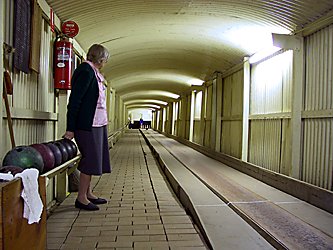![]()
German Traditions, Influences and Leisure Activities
(Before unification in 1871, "Germany" consisted of many independent states and kingdoms. In these pages the word "German" refers to all areas from which the immigrants came.)
| Singing/Music | Kegeln | Weddings | Food | Language Influence | Christmas |
One of the most popular recreational activities of the early German immigrants was singing. They sang not only in church but also formed singing groups, known as Liedertafel. Carl Linger founded the first Liedertafel in Adelaide in 1858, which still exists as part of the South Australian German Association. The " Adelaider Liedertafel 1858" is the oldest continuously operating male choir in Australia. In 1862 a Liedertafel was established in Tanunda (Barossa), which is also still in existence. Music was an important social activity and every German settlement of significant size in the 19th century had a brass band. Usually the girls learned the piano and the boys learned brass instruments.
Singing is still a popular activity in the German-speaking clubs of Australia. The Club Tivoli in Melbourne still has its "Liedertafel Arion", founded in 1860. At the SAADV in Adelaide people can also join the German Folk Dance Group (Deutscher Volkstanzkreis) and the German Folksong Choir (Deutscher Volksliederchor). There are similar choirs for women and men at Melbourne's Club Tivoli as well as in clubs in other Australian states.
The historic Kegelbahn, or skittles alley, was built in 1858 in Herr Paul Fischer's tea gardens at the southern end of Tanunda. It is the only Kegelbahn still in existence in Australia. In earlier times there were Kegelbahns in various Australian towns.

'deutsche Kegelbahn'
Ad for a Melbourne café
in "Germania, Allgemeine deutsche Zeitung für Australien" 24/03/1864
10-pin-bowling is a much more recent development in Australia than Kegeln; the first 10-pin-bowling alley was built in Sydney in 1937. However, that alley did not take off and it wasn't until 1960 that 10-pin-bowling became popular, when an 8-lane manually operated bowling centre was built at Glenelg in South Australia.

The Tanunda Kegelbahn quickly became popular in the 19th century. The bowling competitions were social events, held mostly on Sunday afternoons from 1:30 pm until 5:30 pm. Coffee and German cakes were served. In the 19th century there were two bowling lanes; since 1898 there has been only one lane.

Kegelbahn, Tanunda, April 2002
In 1931 the Kegelbahn was dismantled and reassembled at the Tanunda Showgrounds. The scoring system in Kegeln is quite complex in comparison with 10-pin-bowling. To leave only the front pin (Kegel)of the nine pins standing is a great achievement; it gets you 60 points. The Tanunda Kegelklub is still active today, and in May 2001 the historic alley was renovated thanks to a heritage grant from the government.
(Source: Hampel, Les. 1998. The Tanunda Kegel Club, 1858-1998. The History of a Club and the Pastime of Bowling. The Tanunda Kegel Club Inc. Tanunda [S.A.].)
|
In the German settlements weddings were great celebrations that could
last for days. The wedding ceremony was held on a weekday, often on a
Thursday. As was the case in Germany, in the 19th century German brides
in Australia did not wear a white wedding dress, but a black one, with
a white veil. Federschleißen was a common activity before the wedding;
the friends and relatives of the betrothed couple met in order to make
feather beds from goose down. The Polterabend was another important
custom - the friends of the couple gathered in front of the house of the
bride's parents on the evening before the wedding and made lots of noise
with pots and pans and the like. Later in the evening they were all invited
into the house for a drink and something to eat. Often people played pranks
on the groom, for example they set his horse loose or something similarly
inconvenient. After the wedding the married couple left the church on
the traditional German-style wagon. |
|
Food is another way in which German-speaking immigrants have influenced
life in Australia, especially in South Australia. The German immigrants
brought their own recipes with them from Germany, and these Prussian cooking
traditions and recipes were translated and modified according to local
conditions in the Barossa. Many of these foods are still popular amongst
the general population around South Australia. Of course the German settlers
made lots of different types of sausage: Mettwurst, Blutwurst, Leberwurst,
Weißwurst etc. Streuselkuchen was the typical everyday cake (it's
still common in South Australia, though better known as "German cake"
or "crumble-top cake"). Honey biscuits were also popular, especially
at Christmas time. |
| Top | Back
| Chronology | Issues
| Students | Site Map |
auf Deutsch |
| Primary Sources (in German) | Bibliography
| Search |
German Australia © D. Nutting 2001